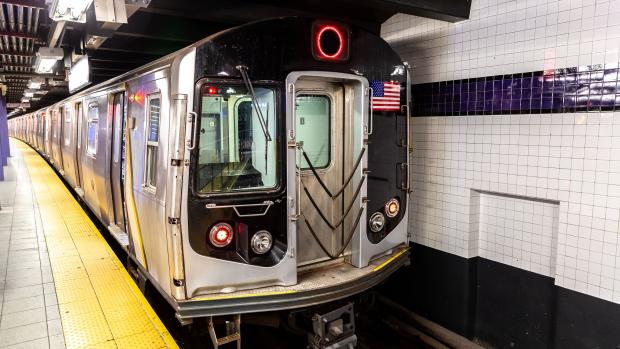Subway air pollution disproportionately impacts New York City's minority and low-income commuters

A comprehensive study on New York City's subway air quality has revealed that longer commute times lead to higher exposure to hazardous air pollutants, a problem that disproportionately affects minority and low-income communities who endure more prolonged and frequent travel through the system.
In a paper published in PLOS ONE, NYU Tandon School of Engineering researchers modeled subway riders' typical daily commutes to determine exposure to particulate matter pollution (PM2.5). This was done by integrating home-to-work commute data with pollutant measurements the researchers collected from all platforms and within a typical car in all train lines throughout the NYC subway system.
Masoud Ghandehari -- a professor in NYU Tandon’s Civil and Urban Engineering Department and a member of C2SMARTER, a Tier 1 University Transportation Center designated by the U.S. Department of Transportation -- led the research team. Other researchers on the paper include its first author, Shams Azad, who earned a Ph.D. in Transportation Engineering from NYU Tandon in 2023, and Pau Ferrar-Cid, Machine Learning Researcher at Universitat Politècnica de Catalunya in Spain who was an NYU Tandon visiting scholar in 2022.
PM2.5 refers to tiny particles suspended in the air that, when inhaled, can enter the lungs and potentially the bloodstream, causing a range of short- and long-term health complications. These include respiratory and cardiovascular diseases, and some components have also been identified as neurotoxins.
PM2.5 are traditionally byproducts of fossil fuel combustion. In the subway system, however, the particles are introduced as a result of abrasion of breaks, rails, and wheels, contributing to very high iron content in the collected and analyzed particles.
An NYC Air Pollution Exposure Map the researchers created can be used to calculate personal exposure for any origin and destination within New York City.
The burden of disease due to exposure to poor air quality in the subway system does not fall equally, the study found. Black and Hispanic workers face PM2.5 exposure levels 35% and 23% higher, respectively, compared to their Asian and white counterparts, according to the study.
This disparity stems from differences in commuting trends, duration of subway travel, and the varying pollution levels across stations and lines. Minority workers residing in low-income communities often endure longer commutes, transferring through stations (which are more polluted than subway cars) in order to reach job hubs like downtown Manhattan.
Economically disadvantaged communities generally are exposed to more pollutants compared to affluent workers. A positive correlation was identified between the percentage of residents below the poverty line and higher levels of PM2.5 exposure.
This discrepancy is partly attributed to the reliance on the subway system among lower-income populations, who have limited access to alternative transportation options like private vehicles or carpool services. Conversely, many affluent workers can avoid lengthy subway commutes by living in proximity to their workplaces.
In fact, residents in upper Manhattan neighborhoods, including Washington Heights and Inwood — two communities with poverty rates above citywide averages — have the highest per capita levels of subway pollutant commuting exposure, the study shows. This is due to a combination of a large number of commuters and longer commute time. Midtown Manhattan — where many people live close to workplaces — and portions of Queens without easily accessible subway stations have some of the lowest per capita exposure levels.
Measurements were carried out in December 2021 and June 2022, sampling 19 distinct subway lines and 368 stations. The researchers took end-to-end round trips on each of the lines studied, measuring the PM2.5 concentration at one-second sampling intervals. In one direction they stayed on the train from start to end. On the return trip they got off at each station and waited until the arrival of the next train, measuring the platform concentrations at the same sampling interval.
Sampling of the platform air at one-second intervals confirmed that pollutant concentration peaks when the train arrives, where the train churns up the pollutants deposited in the tunnel throughout years of service. The concentration values from the 2021 study can be found in a paper published in Atmospheric Pollution Research.
To calculate PM2.5 exposure, researchers used origin-destination records from the U.S. Census Bureau (specifically the 2019 LEHD Origin-Destination (OD) dataset) to simulate home-to-job commutes of over 3 million workers in Manhattan, Brooklyn, the Bronx, and Queens in 2019, calculating the average per capita daily PM2.5 exposure in 34,000 census blocks.
This study was a collaboration between the NYU Tandon School of Engineering and the NYU Grossman School of Medicine, in partnership with the Polytechnic University of Catalunya. The work was funded by NYU Tandon's C2SMART Center, with a grant from the U.S. Department of Transportation’s University Transportation Centers Program under Grant Number 69A3551747124, and by the National Science Foundation (award number 1856032). For more information, see also A Comprehensive Analysis of the Air Quality in the NYC Subway System (September 2022).
Azad, S., Ferrer-Cid, P., & Ghandehari, M. (2024). Exposure to fine particulate matter in the New York City subway system during home-work commute. PLOS ONE, 19(8), e0307096. https://doi.org/10.1371/journal.pone.0307096





